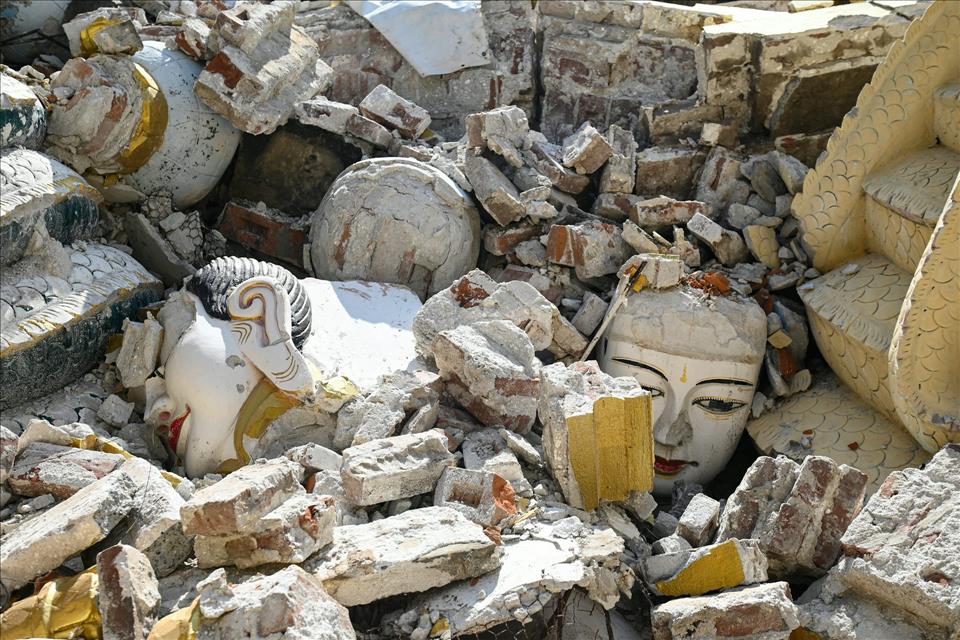The First Video Of Earth's Surface Lurching Sideways In An Earthquake Offers New Insights Into This Force Of Nature
Tectonic plate boundaries are where chunks of Earth's crust slide past each other – not smoothly, but in sudden, violent ruptures.
The footage shows Earth's surface lurching sideways, like a gigantic conveyor belt switched on for just a second, as the fault slips.
What we're seeing is the propagation of a large earthquake rupture – the primary mechanism that accommodates plate boundary motion at Earth's surface. These shear fractures travel at several kilometres per second, making them notoriously difficult to observe.
This video explains the moment Myanmar's Sagaing Fault ruptured in a large earthquake, allowing the tectonic plate boundary to shift. Research:
These rare events, separated by centuries, have shaped our planet's surface over millions of years, creating features such as Aotearoa New Zealand's Alpine Fault and the Southern Alps.
Until now, seismologists have relied on distant seismic instruments to infer how faults rupture during large earthquakes. This video sheds new light on the process that radiates seismic energy and causes the ground to shake.
Analysis of the videoIn our new study , we analysed the video frame by frame. We used a technique called pixel cross-correlation to reveal that the fault slipped 2.5 metres sideways over a duration of just 1.3 seconds, with a maximum speed of 3.2 metres per second.
The total sideways movement in this earthquake is typical of strike-slip fault ruptures, which move the land sideways (in contrast to faults that move land up and down).
But the short duration is a major discovery.
The timing of when a fault starts and stops slipping is especially difficult to measure from distant recordings, because the seismic signal becomes smeared as it travels through Earth.
In this case, the short duration of motion reveals a pulse-like rupture – a concentrated burst of slip that propagates along the fault like a ripple travels down a rug when it's flicked from one end.
Capturing this kind of detail is fundamental to understanding how earthquakes work, and it helps us better anticipate the ground shaking likely to occur in future large events.
Validation of the 'slickenline' hypothesisOur analysis also revealed something more subtle about the way the fault moved.
We found the slip didn't follow a straight path. Instead it curved. This subtle curvature mirrors patterns we've observed previously at fault outcrops .
Called“slickenlines”, these geological scratch marks on the fault record the direction of slip.
Our work shows the slickenlines we see on outcrops are curved in a manner similar to the curvature seen in the CCTV footage. Based on our video analysis, we can be certain that curved slip occurs, giving credence to our interpretations based on geological observations.
In our earlier research , we used computer models to show that curved slickenlines could emerge naturally when an earthquake propagates in a particular direction. The Myanmar rupture, which is known to have travelled north to south, matches the direction predicted by our models.
This alignment is important. It gives us confidence in using geological evidence to determine the rupture direction of past earthquakes, such as the curved slickenlines left behind after the New Zealand Alpine Fault's 1717 earthquake .
This first glimpse of a fault in motion shows the potential for video to become a powerful new tool in seismology. With more strategic deployments, future earthquakes could be documented with similar detail, offering further insight into the dynamics of fault rupture, potentially revolutionising our understanding of earthquake physics.

Legal Disclaimer:
MENAFN provides the
information “as is” without warranty of any kind. We do not accept
any responsibility or liability for the accuracy, content, images,
videos, licenses, completeness, legality, or reliability of the information
contained in this article. If you have any complaints or copyright
issues related to this article, kindly contact the provider above.
Most popular stories
Market Research

- Motif AI Enters Phase Two Of Its Growth Cycle
- 1Inch Unlocks Access To Tokenized Rwas Via Swap API
- Kucoin Presents Kumining: Embodying Simple Mining, Smart Gains For Effortless Crypto Accumulation
- With Seal, Walrus Becomes The First Decentralized Data Platform With Access Controls
- Jpmorgan Product Head Joins GSR Trading MD To Build Institutional Staking Markets
- Innovation-Driven The5ers Selects Ctrader As Premier Platform For Advanced Traders






















Comments
No comment